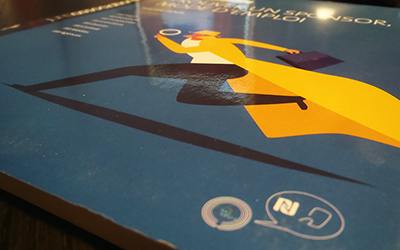QR Code – NFC: Why every book you publish in 2022 should have it

Add QR codes and NFC tags to show your readers additional materials via videos, images or even audio clips.
With the advent of technology, people’s attention has dramatically diminished.
According to a Microsoft Canada survey, the average attention time for the average person today is only 8 seconds. (It was 12 seconds in year 2000)
Scrolling through social media apps endlessly and pausing to read compelling article titles is probably the only thing most people read in a day.
Almost all books are now available as ebooks, and paperbacks are slower to order and read. In addition, reading on your Kindle is convenient because you can carry your entire library with you wherever you go.
But rest assured, this is not the end of the books. A majority of bibliophiles still enjoy reading a physical book. As proof, the still high number of physical books sold each year.
Most of the books you read on the train, at the beach, etc. will be in electronic version, but when it comes to a larger book most people will prefer to consult the paper version. This is where it becomes important to add a digital touch to your work, so that the reader can discover more. (There is no clickable link on paper)
And to connect the online world and the offline world, you can always use a QR code. Or, even better, an NFC tag.
You can create a QR codes to help you connect with your readers online and make their reading experience much more enjoyable. You can place an NFC tag to make this access even easier for your reader. An NFC tag is even easier to read than a QR code.
What can QR codes or NFC tags do for your book?
Engage your readers with additional content on their Smartphone. Get in touch with your readers, generate interaction, show them extra content, share some images or videos, make people want to buy the book.
Keep your readers engaged by adding video and image QR codes.
Add QR codes to show your readers additional materials via videos, images or even audio clips.
For example, if you’re writing a cookbook, adding a QR code to guide your readers to a video tutorial will help them understand the process more easily and quickly. It also works if you are the author of a textbook. Add a video QR code with text explaining the complex concept, or show the reader additional images.
The use of video QR code with young students is particularly useful. Educator Nadine Gilkison did it with storybooks. To make the storytelling more interactive and fun, she created cards with unique QR codes that, when scanned, displayed the corresponding videobook on the device. The card has a colorful image from the storybook and next to it a unique code, all inside a drawing of a mobile frame. When scanned using a smartphone or tablet, students are taken to a video book on Storyline Online, where celebrities read stories for children. These cards can be used in class or even sent home.
Find out what readers think of your book
Give you feedback when your readers are reading your book. In this way, you can get feedback on each chapter, for example, as well as general feedback about the book. Add code at the end of the book or after each chapter to direct the reader to the review page.
To keep your readers engaged after reading
- Change the content of your QR code or NFC tag over time to encourage your reader to come back regularly to discover your news. Keep your readers in the loop: Include a dynamic QR code so your readers can be notified of updates to your new book, book club meetup, and more.
- Direct readers to your social media or website to increase traffic: Print a QR code on the back of your book linking your social media profiles or website so your readers can follow you. This way you can also interact with your readers, further increasing engagement. It will also ensure that there is traffic to your website.
- Encourage your readers to leave a review or comment about your book on different platforms.
Test your QR code and make sure it works until its expected period
Before printing and distributing your QR code, be sure to test it several times using different operating systems. First ask those around you to scan the code on their respective Smartphones. This should help you determine if your code is working. Also, be sure to pay your subscription fees on time so that your code never stops working. Remember to choose the size and contrast of your QR code carefully to ensure good readability on all devices. See our article on best practices for QR code
We strongly advise you to use a dedicated platform for the content of your QR code or NFC tag. You will thus be certain that your content will be perfectly readable on your reader’s Smartphone. Dedicated platforms also allow you to change the final destination of your QR code or NFC tag. Dedicated platforms like the one offered by Ma Balise offer you the advantage of linking specific content to each of your books. This is much more effective than a link to your website, which is more general in nature, where the reader must find the content that interests him. By arriving on a dedicated page, your reader finds exactly what he is looking for about the book he has in hand. Of course, you will have taken care to add links to your site and your online store so that the user can easily continue his visit and generate new purchases.
Contact us to find out how to set up an NFC or QR code campaign for your next edition.

